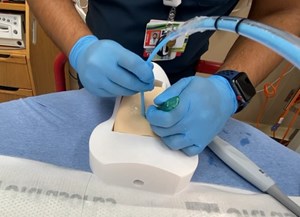
Advanced Critical Care Echocardiography: An Expiring Pathway to Certification for Emergency Physicians
Stephen Alerhand, MD, Department of Emergency Medicine, Rutgers New Jersey Medical School
Nova Panebianco, MD, MPH, FACEP, Department of Emergency Medicine, University of Pennsylvania
History, Terminology, and Scope of Cardiovascular Ultrasound in the Emergency Department
The scope of cardiovascular ultrasound in Emergency Medicine (EM) has evolved considerably over the past few decades. In 1999, the American Medical Association passed Resolution H-230.906 “affirming that ultrasound (US) imaging is within the scope of practice for appropriately trained physicians.” It recommended that hospital credentialing committees follow specialty-specific guidelines for necessary training requirements for sonography competency. The American College of Emergency Physicians (ACEP) Ultrasound Guidelines1 and Imaging Criteria Compendium2 (published in 20013 and 2006,4 respectively) were instrumental in the establishment of modern-day point-of-care ultrasound (POCUS). In 2014, an international consensus document identified focused cardiac ultrasound (FoCUS) as “separate from the standard comprehensive echocardiogram, that is performed by appropriately trained clinicians, typically not cardiologists, to ascertain the essential information needed in critical scenarios for time-sensitive clinical decision making” to clarify the scope and semantics.5
POCUS is a specialty agnostic imaging modality that improves diagnostic accuracy, reduces unnecessary testing, can be performed safely at the point-of-care to enhance patient care by an appropriately trained physician. The examination has been largely defined as performed at the point-of-care, by the physician, to answer a clinical question. The scope, training, image archival, and documentation expectations for POCUS exams have been largely delegated to the medicine specialties to define.6 Conventional echocardiography or “consultative echocardiography” is highly protocolized, has clear training guidelines, quality control, and typically employs sophisticated technology capable of intricate hemodynamic assessment.6 In this paradigm, the individual performing and/or interpreting the exam has no direct involvement in the clinical care of the patient for who was receiving the exam. Recently, the term “Cardiac POCUS” has gained momentum as it piggybacks on general POCUS practice and is distinct from consultive echocardiography.7
This brief review of the history of cardiovascular ultrasound illuminates why the development of a National Board of Echocardiography (NBE) Critical Care Echocardiography Examination (CCEeXAM) certification was both timely and unique.8 While there is significant controversy with conflating POCUS with the physical exam, there is a historical analogy. POCUS is broadly used across the specialties. However, siloed semantics, heterogeneous training requirements, and disparate documentation practices have resulted in ambiguity, lack of transparency, and lack of trust in the skill set. Imagine the confusion and frustration of physicians and patients if the physical exam was taught in medical school as specialty-specific with unique indications and scope and no consensus on terminology, yet this is exactly the issue with POCUS. The unique strength of the NBE CCEeXAM examination and certification process is that it was developed through multispecialty collaboration including Emergency Medicine, Critical Care, Anesthesia, and Cardiology with consensus on exam content, passing rate, and pathways to certification. When an CCEeXAM-certified provider, regardless of specialty, reports on a critical care echocardiography examination, there should be no ambiguity as to whether they have met a standard bar of knowledge and competence set forth by the NBE.
Lastly, CCE is performed at the point-of-care, typically by a non-cardiologist, to answer clinical questions, which falls within the definition of POCUS. However, NBE certification in CCE requires a physician to achieve the same standard requirements of a Diplomat in Echocardiography. Therefore, CCEeXAM Diplomats achieve the historic intersection of POCUS and echocardiography, and this may be the most compelling reason to take the exam and get certified.
Prior Opportunities for Echocardiography Certification Available to Emergency Physicians
The Registered Diagnostic Cardiac Sonographer (RDCS) certification in Adult Echocardiography has historically been available through prerequisite pathway 4A1 to EM residents from ACGME-accredited residencies with didactic and clinical training in US. Prior to wide-scale adoption of POCUS and the Advanced Emergency Medicine Ultrasound certification examination, RDMS certification was a valuable option for EM physicians who needed evidence of merit that was a pre-existing standard at their institution. In data obtained from a 2010 survey study, 71% (41/58) of responding US fellowship-trained individuals who graduated between 1997-2007 reported having obtained RDMS certification.9 In contrast, of those who graduated in 2018, only 44% (7/16) had obtained RDMS certification.
Background on the Examination of Special Competence in Critical Care Echocardiography (CCEeXAM)
National-level certification in echocardiography through the NBE has historically been available only to cardiologists. Whereas other clinicians were permitted to sit for the exam and achieve “Testamur” status, certification itself required cardiology fellowship training. First administered in January 2019, the Examination of Special Competence in Critical Care Echocardiography was developed by the NBE and nine other professional societies including ACEP. The purpose of certification is to “establish the domain of critical care echocardiography, enhance its quality, foster individual professional growth within it, and serve the public by encouraging quality in its practice, while also formally recognizing individuals who satisfy the requirements” (CCeXAM handbook).
Early Data on CCeXAM Test-Takers
Over the first three years of this examination’s offering (2019-21), of 1,099 physicians who sat for the examination, emergency physicians were represented 4th (n=55, 5%) after pulmonary/critical care (n=529, 48.1%), anesthesia (n=292, 26.7%), and “other” (n=173, 15.7%), respectively. The majority of examinees self-reported having < 6 years of echocardiography practice (n=817, 74.3%) and work full-time in academic hospitals. The mean passing score for all takers in the first 3 years of the examination was 82.1%, and 87.1% for emergency physicians.
How Can Emergency Physicians Obtain Certification?
By successfully passing the examination, a physician is granted Testamur status. To obtain Diplomat certification, emergency physicians not completing Critical Care Fellowship training can proceed through the Practice Experience Pathway (CCeXAM handbook). The practice experience pathway will no longer be available for those completing their core residency after 12/31/2026.
Applicants must also have their supervisor attest to a minimum of 750 hours of clinical experience dedicated to the evaluation and management of critically ill patients over the 3 years prior to application. Applicants must also perform and interpret a minimum of 150 complete medically necessary critical care transthoracic echocardiography examinations over the same time period. Up to one serial examination per single patient can count towards that minimum requirement. These examinations must be documented chronologically in a log and include the date, indications, findings, and diagnosis, with a subset reviewed by a supervisor. The log must have sufficient information to demonstrate that the examination was performed on a critically ill patient and its complexity met the criteria of CCE. The log must be reviewed by a supervisor with NBE certification in echocardiography (ASCeXAM, CCeXAM, APTEeXAM) or who has achieved ASCeXAM/ReASC/CCEeXAM Testamur status within the past 10 years and be a recognized expert in CCE. Physicians must also present documentation of at least 20 hours of AMA category 1 CME devoted to echocardiography during the 3 years prior to application. Certification remains valid for 10 years from the date of passing the examination.
Reasons for Emergency Physicians to Pursue CCeXAM Certification
The knowledge and technical study required to pass the written examination and accumulate the requisite image sets, respectively, confer an expertise beyond what is expected of general emergency medicine providers. NBE certification demonstrates a knowledge base far beyond that described in the ACEP Ultrasound Guidelines and Imaging Compendium that is shared with echocardiologists but with a skill set unique to critical care. Certification establishes that the physician has achieved the ability to independently perform and interpret critical care echocardiography at a standard recognized by professional societies from critical care to cardiology. The American Board of Emergency Medicine offers a Focused Practice Designation in Advanced Emergency Medicine Ultrasonography, but it is not specific to cardiac ultrasound or critical care.
While certification is not required to perform advanced cardiac ultrasound, it can be valuable to the emergency physician for several reasons. First, the exam is challenging and the knowledge base needed to pass the examination will help emergency physicians deliver the highest quality care for critically ill patients in the emergency department. Second, certification can facilitate career development by adding to one’s promotion portfolio. Third, within academic teaching hospitals and EM residencies, a higher degree of expertise will also confer better downstream education for US fellows and residents. Fourth, certification can add to institutional credibility for EM when interacting and consulting with other services such as Cardiology, Anesthesia, and Critical care. Finally, certification may also increase likelihood of compensation by third-party payers.
A Closing Window for Emergency Physicians to Obtain Certification
The Practice Experience Pathway to CCeXAM certification will expire for those completing their EM residency after 12/31/2026. As a result, any emergency physician completing residency in 2027 and beyond (and not completing a Critical Care Fellowship) will be able to sit for the CCeXAM and obtain Testamur status, but not obtain full Diplomat certification.
References
- American College of Emergency Physicians. Ultrasound Guidelines: Emergency, Point-of-Care and Clinical Ultrasound Guidelines in Medicine [policy statement]. Ann Emerg Med. 2017;69(5):e27-e54.
- American College of Emergency Physicians. Emergency Ultrasound Imaging Criteria Compendium. [policy statement]. Ann Emerg Med. 2016;68(1):e11-48.
- American College of Emergency Physicians. Emergency Ultrasound Guidelines 2001 [policy statement]. Ann Emerg Med. 2001;38(4):470-81.
- American College of Emergency Physicians. Emergency ultrasound imaging criteria compendium [policy statement]. American College of Emergency Physicians. Ann Emerg Med. 2006;48(4):487-510.
- Via G, Hussain A, Wells M, et al. International evidence-based recommendations for focused cardiac ultrasound. J Am Soc Echocardiogr. 2014;27(7):683 e1-683 e33.
- Johri AM, Glass C, Hill B, et al. The Evolution of Cardiovascular Ultrasound: A Review of Cardiac Point-of-Care Ultrasound (POCUS) Across Specialties. Am J Med. 2023.
- Kirkpatrick JN, Grimm R, Johri AM, et al. Recommendations for Echocardiography Laboratories Participating in Cardiac Point of Care Cardiac Ultrasound (POCUS) and Critical Care Echocardiography Training: Report from the American Society of Echocardiography. J Am Soc Echocardiogr. 2020;33(4):409-422 e4.
- Panebianco NL, Mayo PH, Arntfield RT, et al. Assessing Competence in Critical Care Echocardiography: Development and Initial Results of an Examination and Certification Processes. Crit Care Med. 2021;49(8):1285-92.
- Moak JH, Gaspari RJ, Raio CC, et al. Motivations, job procurement, and job satisfaction among current and former ultrasound fellows. Acad Emerg Med. 2010;17(6):644-8.



